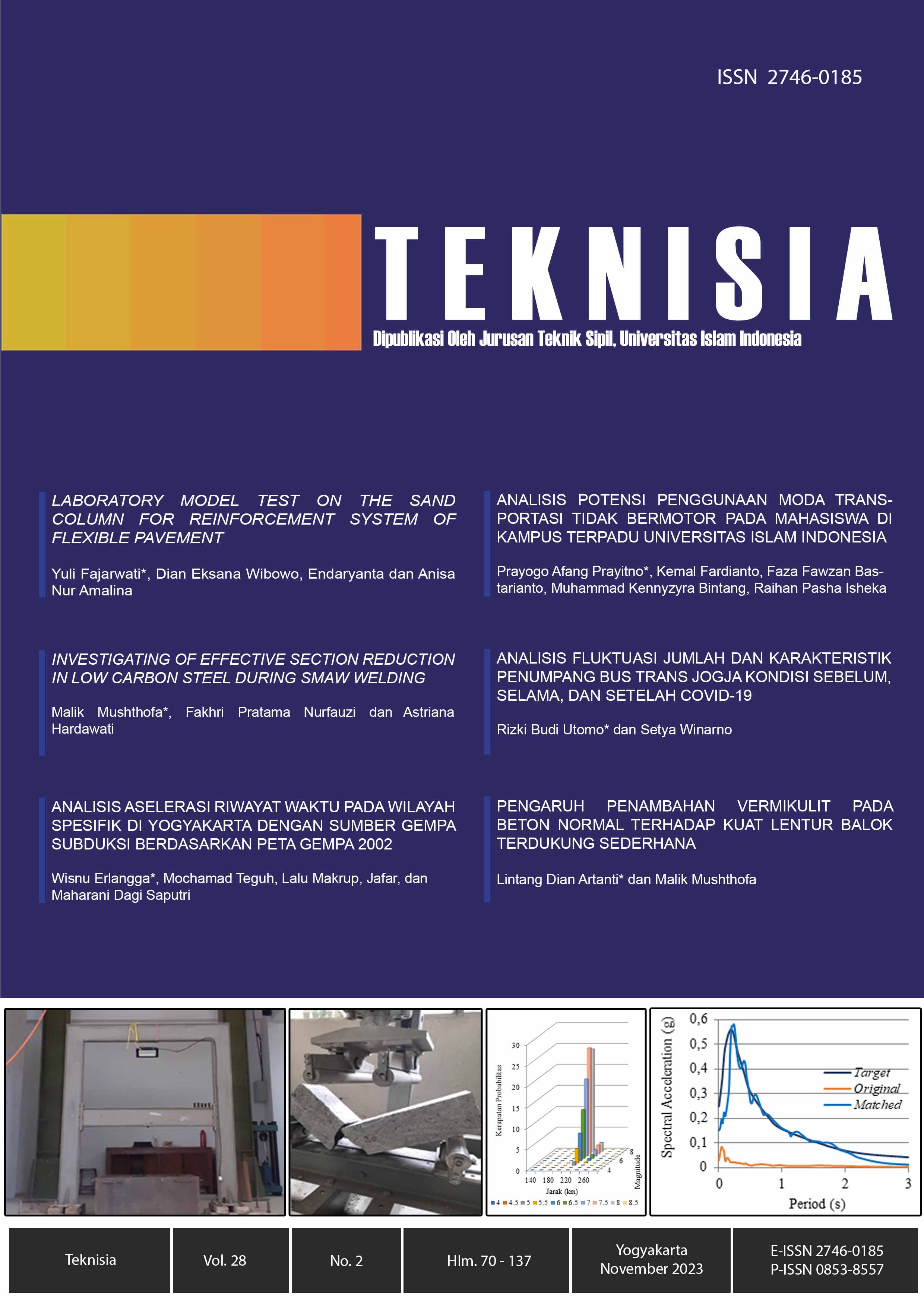Main Article Content
Abstract
Concrete innovation in the construction industry continues to grow until now. One of the substantial innovations made is adding a material called vermiculite. If changes in compressive strength of concrete were observed in the previous study, then changes in concrete weight and flexural strength of concrete with the addition of vermiculite as much as 12%, 24%, and 36% were observed in this study. Concrete specimens were cured with water for 28 days and then weighted and tested for flexural strength with two loading points. The test results show that the lightest concrete is found in concrete with the addition of 36% vermiculite, with a weight difference of 0.03% lighter than normal concrete. Based on the results of the flexural strength test, the addition of 36% vermiculite makes the flexural strength of concrete 42.75% higher than normal concrete. This improvement proves that vermiculite's high water absorption properties can reduce the excess water content in concrete to reduce its weight, making the concrete denser and increasing its flexural strength.
Keywords
Article Details
Copyright (c) 2023 Teknisia

This work is licensed under a Creative Commons Attribution-ShareAlike 4.0 International License.
Under the following term:
-
Attribution — You must give appropriate credit, provide a link to the license, and indicate if changes were made. You may do so in any reasonable manner, but not in any way that suggests the licensor endorses you or your use.
-
ShareAlike — If you remix, transform, or build upon the material, you must distribute your contributions under the same license as the original.
- No additional restrictions — You may not apply legal terms or technological measures that legally restrict others from doing anything the license permits.
References
- Amalia, Dewi, and Hendry. 2014. “Kajian Peningkatan Nilai Cbr Tanah Lempung Padalarang Yang Distabilisasi Dengan Vermikulit Dan Semen.” Prosiding Seminar Nasional Aplikasi Teknologi Prasarana Wilayah (December):91–105.
- Badan Standarisasi Nasional. 2017. “SNI-8457:2017 : Rancangan Tebal Jalan Beton Untuk Lalu Lintas Rendah.” Badan Standardisasi Nasional.
- Dian, Lintang, and S. Syahril. 2023. “Effect of Vermiculite Addition on the Compressive Strength of Concrete.” The 2Nd International Conference on Design, Energy, Materials and Manufacture 2021 (Icdemm 2021) 2568(June 2022):040004. doi: 10.1063/5.0115987.
- KOÇYİĞİT, Şermin, and Vedat Veli ÇAY. 2019. “Investigation of Mechanical and Thermal Behavior of Basalt Cutting Waste (Bcw) Added Clay Brick.” European Journal of Technic 9(2):209–18. doi: 10.36222/ejt.643209.
- Koksal, Fuat, Emrah Mutluay, and Osman Gencel. 2020. “Characteristics of Isolation Mortars Produced with Expanded Vermiculite and Waste Expanded Polystyrene.” Construction and Building Materials 236:117789. doi: 10.1016/j.conbuildmat.2019.117789.
- Mo, Kim Hung, Hong Jie Lee, Michael Yong Jing Liu, and Tung Chai Ling. 2018. “Incorporation of Expanded Vermiculite Lightweight Aggregate in Cement Mortar.” Construction and Building Materials 179:302–6. doi: 10.1016/j.conbuildmat.2018.05.219.
- Neville, A. M., and J. J. Brooks. 1981. Concrete Technology. 2nd ed. England.
- Prakash, K. E., D. M. Sangeetha, and Shakeel Bagwan. 2019. An Experimental Study on Partial Replacement of Fine Aggregate by Vermiculate and Cement by Marble Powder. Springer Singapore.
- Pretty, Dian. 2009. “Studi Karakteristik Fisik Dan Mekanis Beton Ringan Beragregat Kasar Ringan Daur Ulang Botol Plastik Shampo Polietilen Densitas Tinggi (HDPE).” Universitas Indonesia.
- Silva, L. M., R. A. Ribeiro, J. A. Labrincha, and V. M. Ferreira. 2010. “Role of Lightweight Fillers on the Properties of a Mixed-Binder Mortar.” Cement and Concrete Composites 32(1):19–24. doi: 10.1016/j.cemconcomp.2009.07.003.
- Suvorov, S. A., and V. V. Skurikhin. 2003. “Vermiculite - A Promising Material for High-Temperature Heat Insulators.” Refractories and Industrial Ceramics 44(3):186–93. doi: 10.1023/A:1026312619843.
- Syahril, and Lintang D.A. 2021. “Kajian Pengaruh Penambahan Vermikulit Terhadap Beton Segar.” Potensi : Jurnal Sipil Politeknik 23(1):51–58. doi: 10.35313/potensi.v23i1.2434.
References
Amalia, Dewi, and Hendry. 2014. “Kajian Peningkatan Nilai Cbr Tanah Lempung Padalarang Yang Distabilisasi Dengan Vermikulit Dan Semen.” Prosiding Seminar Nasional Aplikasi Teknologi Prasarana Wilayah (December):91–105.
Badan Standarisasi Nasional. 2017. “SNI-8457:2017 : Rancangan Tebal Jalan Beton Untuk Lalu Lintas Rendah.” Badan Standardisasi Nasional.
Dian, Lintang, and S. Syahril. 2023. “Effect of Vermiculite Addition on the Compressive Strength of Concrete.” The 2Nd International Conference on Design, Energy, Materials and Manufacture 2021 (Icdemm 2021) 2568(June 2022):040004. doi: 10.1063/5.0115987.
KOÇYİĞİT, Şermin, and Vedat Veli ÇAY. 2019. “Investigation of Mechanical and Thermal Behavior of Basalt Cutting Waste (Bcw) Added Clay Brick.” European Journal of Technic 9(2):209–18. doi: 10.36222/ejt.643209.
Koksal, Fuat, Emrah Mutluay, and Osman Gencel. 2020. “Characteristics of Isolation Mortars Produced with Expanded Vermiculite and Waste Expanded Polystyrene.” Construction and Building Materials 236:117789. doi: 10.1016/j.conbuildmat.2019.117789.
Mo, Kim Hung, Hong Jie Lee, Michael Yong Jing Liu, and Tung Chai Ling. 2018. “Incorporation of Expanded Vermiculite Lightweight Aggregate in Cement Mortar.” Construction and Building Materials 179:302–6. doi: 10.1016/j.conbuildmat.2018.05.219.
Neville, A. M., and J. J. Brooks. 1981. Concrete Technology. 2nd ed. England.
Prakash, K. E., D. M. Sangeetha, and Shakeel Bagwan. 2019. An Experimental Study on Partial Replacement of Fine Aggregate by Vermiculate and Cement by Marble Powder. Springer Singapore.
Pretty, Dian. 2009. “Studi Karakteristik Fisik Dan Mekanis Beton Ringan Beragregat Kasar Ringan Daur Ulang Botol Plastik Shampo Polietilen Densitas Tinggi (HDPE).” Universitas Indonesia.
Silva, L. M., R. A. Ribeiro, J. A. Labrincha, and V. M. Ferreira. 2010. “Role of Lightweight Fillers on the Properties of a Mixed-Binder Mortar.” Cement and Concrete Composites 32(1):19–24. doi: 10.1016/j.cemconcomp.2009.07.003.
Suvorov, S. A., and V. V. Skurikhin. 2003. “Vermiculite - A Promising Material for High-Temperature Heat Insulators.” Refractories and Industrial Ceramics 44(3):186–93. doi: 10.1023/A:1026312619843.
Syahril, and Lintang D.A. 2021. “Kajian Pengaruh Penambahan Vermikulit Terhadap Beton Segar.” Potensi : Jurnal Sipil Politeknik 23(1):51–58. doi: 10.35313/potensi.v23i1.2434.
